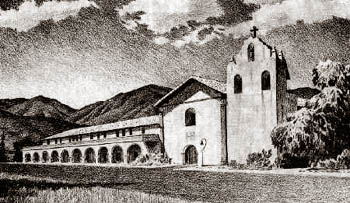Pasquala of Mission Santa Ines
Elaine Jordan
In 1824 a young Indian girl named Pasquala from the Tulare tribe saved Mission Santa Ines from destruction. Her story is a symbol of the love of the Mission Indians for the Franciscan padres and the Catholic Faith.
A sketch of the old Mission Santa Ines, founded in 1804
Mission Santa Ines, the 19th of the California missions, was founded in 1804. It is located between San Luis Obispo and Santa Barbara. A large number of the peaceful Chumash Indians from Mission Santa Barbara came to live in the new mission. Later, others from the fierce Tulare Indians joined them.
Under the wise direction of Father Uría, almost 700 hundred Indians came to live at Santa Ines in its village of white adobe huts. The padres directed the building of an irrigation system, which brought water from the mountains to the orchards and vineyards worked by the Indians. They also learned to make saddles and silver crafting.
A plaque, above, commemorates Pasquala's deed in the Mission gardens, below
Pasquale’s parents had come to the mission when she was just a small child because she was very ill from food poisoning. They remained as neophytes to learn the Catholic Faith and live in the village there. Several years after their arrival, the Tulare Indians went on the warpath, stirred up by the shamans who resented the growing influence of the padres. One day they attacked the mission and killed Pasquale’s father while he was working in the mission vineyards. They kidnapped Pasquala and her mother, whom they took to a Tulare village some miles away. Shortly afterwards, her mother died.
When Pasquala heard that the Tulares were planning a new, larger attack on the mission, she ran away from the village and walked for days through the rocky hills and valleys to reach the mission. When she arrived there, exhausted, she called out to Father Uria, “Padre! Padre! War! War!”
The friar ordered the people to safe quarters and prepared for the oncoming attack. Soldiers from the presidio fought off the Tulare Indians and kept them from destroying the mission.
The difficult journey to the mission was too much for Pasquala. Her remaining strength ebbed away and she died. To reward Pasquala’s courage and loyalty, Father Uría buried the young Indian girl in the church courtyard, a high honor.
After Mexican Independence all of the padres were told to leave the missions and give the land to the Indians. Most of the missions fell apart and the land was taken from those Indians who had been protected by the padres.
Much later, in 1904, Father Alexander Buckler came to the ruins of Mission Santa Ines. He planned to stay for two weeks, but lived at the mission for twenty years. With tireless effort, he began the restoration of the mission. Today it stands as it did at the time of Father Uría.
In the graveyard behind the church you can see many unmarked Indian graves. But one name at least has survived, a placard dedicated to Pasquala telling her story stands in the verdant, well-manicured gardens of Mission Santa Ines, a testimonial to her courage and devotion.
The story of Pasquala of Mission Santa Ines - Elaine Jordan


 LinkBack URL
LinkBack URL About LinkBacks
About LinkBacks





 Citar
Citar
Marcadores